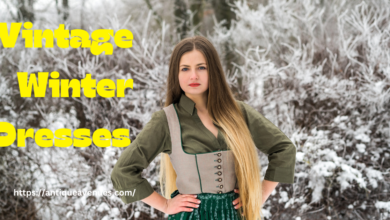How to embroider vintage dresses?

The vintage dress embroidery is an amazing blend of skill and history that brings classic pieces back to life with your unique touch. The presence of flowery designs on the 1950s tea dress and the recreation of a delicate flapper dress from the 1920s, needlework gives past fabrics a new lease of life while maintaining their distinct personality.
These valuables are valuable by following the fundamental procedures of this guide, which include stabilizing fragile components and using stitches appropriate for the period. These approaches, which pay tribute to the past and make wearable heirlooms for the future, are excellent for beginners and professional stitchers alike.
Preparing Your Vintage Dress

Fabric Assessment
Identifying Fabric Types
The various materials used in vintage clothing require particular embroidery techniques. When delicate silks require softer handling, natural fabrics like cotton and linen provide excellent stitching stability. The specialty fabrics and synthetic combinations each provide different difficulties that affect the choice of thread and method.
Fabric Condition Evaluation
The full condition evaluation is essential before starting any needlework project. The garment for any damage that could interfere with your work, such as smaller fabric and weak seams. When testing for colorfastness and structural integrity, embroidered surprises can be avoided.
Cleaning and Repair
Proper Cleaning Methods
When vintage fabrics are cleaned properly, their character is maintained, and they are ready for embroidery. The different textiles need different care; sensitive silks and beaded items need expert dry cleaning, while potent cottons need gentle hand washing.
Essential Repairs
Addressing structural issues before embroidering ensures long-lasting results. Reinforce weak seams, mend holes using period-appropriate techniques, and secure loose embellishments to create a stable foundation for new embroidery work.
Design Selection
Era-Appropriate Patterns
The historically accurate designs maintain a garment’s authenticity. Research period-specific motifs through vintage pattern books, fashion archives, or museum collections to inform your design choices.
Placement Considerations
A garment’s natural silhouette is maintained, while its best characteristics are accentuated through strategic embroidered placement. The effects of stitching on draping and flow while choosing design places.
Essential Tools and Materials
Basic Embroidery Kit
Must-Have Tools
The majority of hoop sizes, needles, and specialty scissors are all included in the full embroidery set. The highest-quality embroidery equipment facilitates the procedure and helps maintain delicate vintage textiles.
Thread Selection
The appropriate threads ensure both aesthetic and structural success. The fiber content, weight, and finish when selecting threads to complement your vintage garment.
Specialized Materials
Stabilizers
Modern stabilizers offer solutions for working with delicate vintage fabrics. The stabilizer types are based on fabric characteristics and the planned embroidery design.
Vintage-Style Embellishments
Authentic-looking embellishments maintain historical accuracy. Source period-appropriate beads, sequins, and trims to enhance your embroidery designs.
Hand Embroidery Techniques

Fundamental Stitches
Outline Stitches
Mastering basic outline stitches provides the foundation for more complex embroidery work. Practice consistency in tension and spacing for professional results.
Filling Stitches
Various filling techniques create different visual and textural effects. Experiment with stitch combinations to achieve your desired design aesthetic.
Era-Specific Techniques
1920s-1930s Styles
The Jazz Age favored lavish embellishment and geometric designs. Study period examples to recreate authentic Art Deco embroidery styles.
1940s-1950s Styles
Postwar embroidery reflected both austerity and renewed optimism. Learn characteristic techniques from these transitional decades in fashion history.
Conclusion:
It is just a craft; embroidery is a method to give beloved clothing a new lease on life, celebrate fashion history, and restore it creatively. When you’re cycling a boho maxi from the sixties, painting floral motifs on a 1950s tea dress, and mending a fragile flapper dress from the 1920s, stitching lets you pay attention to the past while customizing each item.




One Comment